|
| OO Scale | N Scale | G Scale | Z Scale | HO Scale | Slot Cars & R⁄C |
| |||||||
|
|||||||
| Home Page | |||||||
| BUY GIFT VOUCHERS | |||||||
| Products | |||||||
| Latest News | |||||||
| RIGHT LINES | |||||||
| Bargains | |||||||
| Downloads | |||||||
| Events | |||||||
| Careers & Jobs | |||||||
| Carriage Services | |||||||
| About Us | |||||||
| Contact Us | |||||||
| Pay Us A Visit | |||||||
| Meet The Staff | |||||||
| Links | |||||||
| SHOPPING BASKET |
Your shopping basket is empty. To add an item, click the "Buy" button
| YOUR ACCOUNT | ||
|
||||
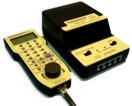 |
||||
| Prodigy Advance Digital System |
||||
| Cased Controllers |
||||
| Panel Mount Controllers |
||||
| Walkabout Controllers |
||||
| Modules & Transformers |
||||
| Scenics & Accessories |
||||
| Wiring & Electrical Components |
||||
| Tiny Signs | ||||
| Tools | ||||
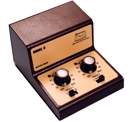 |
||||
| RECENTLY VIEWED |
| MODELSTRIP - Use GM08 |
| O Scale | Wargaming | Architectural | Narrow Gauge | Tools+ | ||
A History of the United States Army Transportation Corps

STUART JORDAN gives an overview of the history of this branch of the American Army.
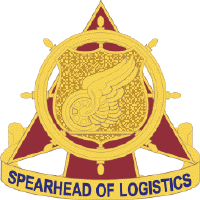
USATC Regimental Insignia
Origins
Since the formation of the United States Army during the American War of Independence in the late 1770s, the logistical and transportation needs of the army were managed by the Quartermaster Corps and the Corps of Engineers. Although there were no railways at this time, these two parts formed the genesis of what would become the United States Army Transportation Corps (USATC) over one-hundred and fifty years later.
American Civil War
The Quartermaster Corps and the Corps of Engineers both stayed separate entities during the American Civil War in the 1860s, but this conflict did see the first widespread military use of an existing rail network to transport supplies and soldiers - although a purpose-built military railway was built by the British Army during the Crimean War to supply the troops besieging Sevastopol in 1855.
The US Army created the United States Military Railroad (USMRR) to manage railways and railway equipment captured from the Confederate States, and the USMRR was a definite precursor to the USATC.
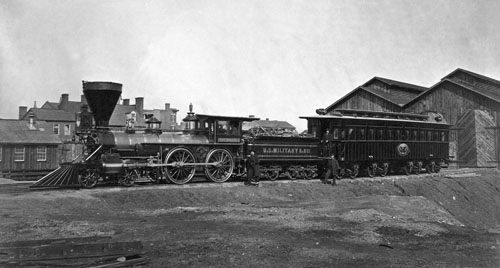
USMRR 4-4-0 locomotive 'WH Whiton' in January 1865 with Abraham Lincoln's presidential car, which later was used as his funeral car after his assassination.
First World War
During the First World War the Quartermaster Corps managed wheeled vehicles and the deep-water fleet, and the Corps of Engineers looked after railroads and harbour craft.
Most of the armies fighting in the First World War ran narrow-gauge trench railways to supply the front lines with ammunition and food, and to bring casualties back to safety. The American Army was no exception.
Around 200 2-6-2T locomotives were built for the army for use overseas by the Baldwin Locomotive Works, and in total over 2000 flat cars, gondolas, tank and side-tipper wagons were built and shipped over to Europe. Such was the capacity of the American locomotive manufacturing industry that at the same time American Locomotive Company (ALCO) was supplying Narrow Gauge locomotives to the British and Russian armies, some of which can be found preserved on narrow-gauge railways such as the Ffestiniog Railway.
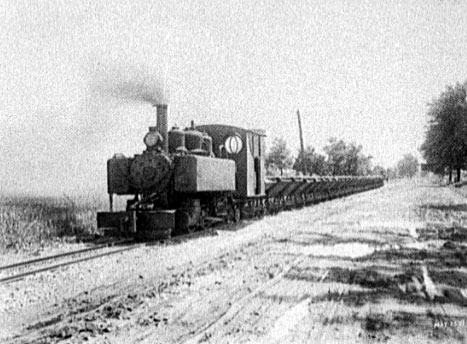
One of the Baldwin 2-6-2T locomotives built for war work, shown in service after the First World War.
Second World War
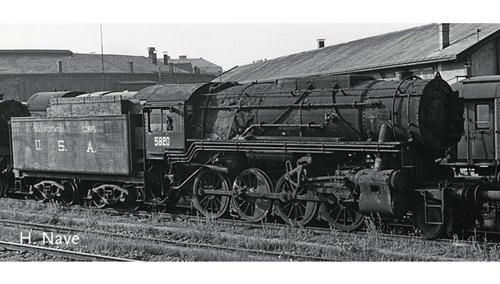
USATC 2-8-0 S-160 Class Steam Locomotive, hundreds of which were built and used across Europe.
After the Japanese bombing of Pearl Harbor, Hawaii, on 7th December 1941, America entered the Second World War. A new army logistics branch was created in July 1942, completely separate from the Corps of Engineers and the Quartermasters Corps, taking control of the Army deep-water fleet, railroad management, and harbour management. The United States Army Transportation Corps was born.
The USATC managed supply and troop movement by railroad both in the US and overseas. 1500 locomotives and 20,000 wagons were built and sent across the Atlantic, some being used in North Africa to supply the port of Birzete in Tunisia which was the staging post for the Allied amphibious invasions of Sicily, Italy, and Southern France in 1943-44.
USATC locomotives were used to bolster the capacity of British railways in the build up to the D-Day landings before being sent to Ebbw Junction in Newport, Wales ready to be sent to France.
Post-War
The greatest achievement of the USATC is thought of by many to be the rebuilding of the shattered rail network of Europe after the Second World War. France in particular had suffered immense damage, from both the advancing Allied army and the withdrawing German army. Locomotives and stock were distributed across Europe to Austria, Czechoslovakia, France, Germany, Greece, Hungary, Italy, Poland, the Soviet Union, Spain, Turkey and Yugoslavia.
As part of the United Nations Relief and Rehabilitation Administration, USATC locomotives were deployed in both China and South Korea, recently abandoned by Japanese forces. The Chinese locomotives found their way to North Korea, so ironically during the Korean War in 1950-53 both the North Koreans and the South Koreans/Americans were deploying USATC locomotives.
After the Korean War the USATC use of railroads became limited, with air transportation becoming more sophisticated and the changes in the nature of warfare.

Roco and Fleischmann are producing models representing locomotives and rolling stock of the USATC used during the Second World War and the Post-War period in HO Scale.
Locomotives
RC72150 USTC S160 Rattlesnake Steam Locomotive II
RC72151 USTC S160 Rattlesnake Steam Locomotive II (DCC-Sound)
RC72152 USTC S160 US Zone Austria Steam Locomotive III
RC72153 USTC S160 US Zone Austria Steam Locomotive III (DCC-Sound)
RC78150 USTC S160 Rattlesnake Steam Locomotive II (~AC)
RC78151 USTC S160 Rattlesnake Steam Locomotive II (~AC-Sound)
RC78152 USTC S160 US Zone Austria Steam Locomotive III (~AC)
RC78153 USTC S160 US Zone Austria Steam Locomotive III (~AC-Sound)
Rolling Stock
RC76862 USTC Flat Wagon with Tank Load II
RC76863 USTC Flat Wagon with Half Track Load II
RC67117 USTC Bogie Tank Wagon Set (2) II
FM573301 USTC Bogie Box Van II
FM526205 USTC Bogie Flat Wagon II
FM526303 USTC High Sided Gondola II

Additional Military Vehicles in HO Scale can be found in the Minitanks range
CLICK HERE to view the Minitanks Range
|
We are always looking to make improvements to our website to try and improve the quality of your visit. We would welcome your feedback and suggestions, so please do not hesitate to e-mail our webmaster with your comments. Alternatively call us on 01903 884488.
Home Cookies Privacy Statement Terms & Conditions Site Map Site Guide
WEEE Regulations Glossary Careers & Jobs
Tel – +44 (0) 1903 884488 Fax – +44 (0) 1903 884377 E-Mail us – click here
Gaugemaster.com is a trading name of Gaugemaster Controls Ltd.
Registered in England No. 2714470, Registered office:
Gaugemaster House, Ford Road
Arundel, West Sussex, BN18 0BN, United Kingdom
VAT Reg. No. 587 8089 71
Copyright © 2003-2014 Gaugemaster Controls Ltd. All Rights Reserved.
















